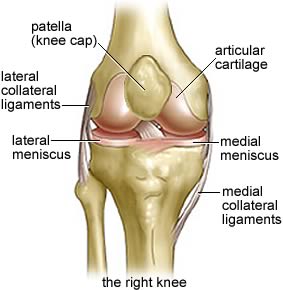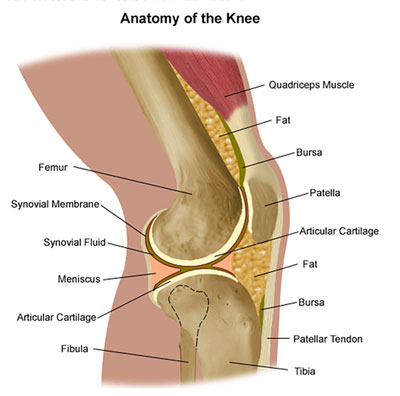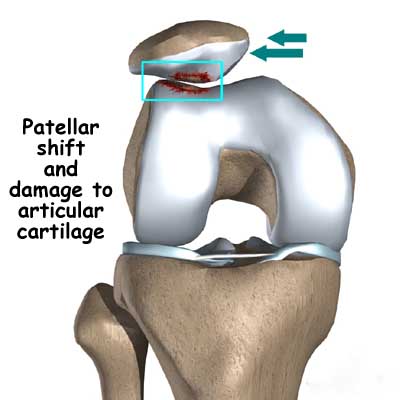Knee Injuries – Many Structures That Can Cause Joint Pain.
 The knee is the largest and most complex of the joints in the body. As such, there are many structures in the knee that can be injured. People frequently talk about “torn cartilage” to which they are most commonly referring to the medial meniscus. Less commonly the lateral meniscus is torn. On the sides of the knee are the medial and lateral collateral ligaments, which are frequently subject to sprain due to their function as lateral knee stabilizers.. Internally the anterior and posterior cruciate ligaments stabilize the knee. These ligaments are responsible for forward and backward motion of the knee. Lastly there is the patellar tendon which attaches the patella (knee cap) to the lower leg bone, the tibia. Sprains of the patellar tendon can be quite painful. Even degenerative arthritis is a common cause of knee pain. When the cartilage in the knee joint wears away, bare bone is exposed. Patients develop bone-on-bone knee pain. Braces, anti-inflammatory agents and injection therapy offer the only non-surgical treatment. Some patients eventually need knee replacements.
The knee is the largest and most complex of the joints in the body. As such, there are many structures in the knee that can be injured. People frequently talk about “torn cartilage” to which they are most commonly referring to the medial meniscus. Less commonly the lateral meniscus is torn. On the sides of the knee are the medial and lateral collateral ligaments, which are frequently subject to sprain due to their function as lateral knee stabilizers.. Internally the anterior and posterior cruciate ligaments stabilize the knee. These ligaments are responsible for forward and backward motion of the knee. Lastly there is the patellar tendon which attaches the patella (knee cap) to the lower leg bone, the tibia. Sprains of the patellar tendon can be quite painful. Even degenerative arthritis is a common cause of knee pain. When the cartilage in the knee joint wears away, bare bone is exposed. Patients develop bone-on-bone knee pain. Braces, anti-inflammatory agents and injection therapy offer the only non-surgical treatment. Some patients eventually need knee replacements.
Non-Surgical Orthopedic Medicine
 Ligament sprains or tears and cartilage tears are among the most common knee injuries. They all involve varying degrees of knee joint pain and swelling. For minor injuries, rest, ice and anti-inflammatory agents are effective. If the pain is more severe or there is marked swelling of the knee, you should see a doctor for further evaluation. Knee x-rays and an MRI are common in being able to find out what exactly is the problem. Even hairline fractures of the bone can be painful. With more severe ligament or cartilage tears, arthoscopic surgery may be needed, particularly for complete ligament tears or severe cartilage tears. Knee rehabilitation in combination with conservative therapy can frequently heal patients without surgery. Wearing an elastic knee brace can help to stabilize the joint and lessen the stress on the knee structures. Cortisone or hyaluronic acid injections can provide relief. Long term or repeated use of cortisone is to be avoided due to risk of worsening the condition. Patients that do go on to have surgery, either arthroscopic or open, can have lasting knee pain – despite adequate rehabilitative therapy. The same is true for meniscus tears. They can heal with or without surgery but patients may be left with lingering pain.
Ligament sprains or tears and cartilage tears are among the most common knee injuries. They all involve varying degrees of knee joint pain and swelling. For minor injuries, rest, ice and anti-inflammatory agents are effective. If the pain is more severe or there is marked swelling of the knee, you should see a doctor for further evaluation. Knee x-rays and an MRI are common in being able to find out what exactly is the problem. Even hairline fractures of the bone can be painful. With more severe ligament or cartilage tears, arthoscopic surgery may be needed, particularly for complete ligament tears or severe cartilage tears. Knee rehabilitation in combination with conservative therapy can frequently heal patients without surgery. Wearing an elastic knee brace can help to stabilize the joint and lessen the stress on the knee structures. Cortisone or hyaluronic acid injections can provide relief. Long term or repeated use of cortisone is to be avoided due to risk of worsening the condition. Patients that do go on to have surgery, either arthroscopic or open, can have lasting knee pain – despite adequate rehabilitative therapy. The same is true for meniscus tears. They can heal with or without surgery but patients may be left with lingering pain.

PRP therapy (platelet rich plasma) can provide hope for patients with chronic knee pain. For patients that have not had surgery but have failed other conservative treatment, PRP can frequently provide the long term pain relief they are looking for and needing. Depending on the severity of the injury, 1-3 PRP treatments may be necessary. If more than one treatment is needed, they are given at 4 week intervals. Even for patients that have had surgical repair of torn ligaments and cartilage, who have persistent pain, PRP can provide pain relief and tissue healing. The procedure for knee injuries is similar to other PRP procedures: the area of tenderness is identified. The skin is prepped with an iodine solution and local anesthesia is administered. PRP is then injected into the knee joint and activation is accomplished with thrombin injection. With this there can be some discomfort, minor inflammation, pressure and swelling. Compression with an Ace wrap and ice packs can help. Tylenol products or mild pain killers can be used for a few days. Most patients do well after a few days. Healing occurs over the next 6 weeks. If another PRP injection is required, it is usually done at 4 weeks. During the healing phase all anti-inflammatory agents should not be taken. Use Tylenol products (acetaminophen) only. In a majority of cases, the results are quite dramatic, with most patients getting excellent results. Even for patients that have had knee surgery, who have residual pain, PRP therapy can provide them a reasonable alternative with a relatively high degree of success in being pain free. As with any injection procedure, there is always the risk of infection but PRP has inherent bactericidal action, minimizing this risk. There is also the risk of increased pain, failure to respond, swelling or injury to neurovascular structures in the area of injection.
If you have knee pain that is bothering you, whether or not you have had surgery, you may be an excellent candidate for PRP therapy. Ask your doctor for evaluation for this treatment. Contact Sarasota Neurology for a PRP consultation.
